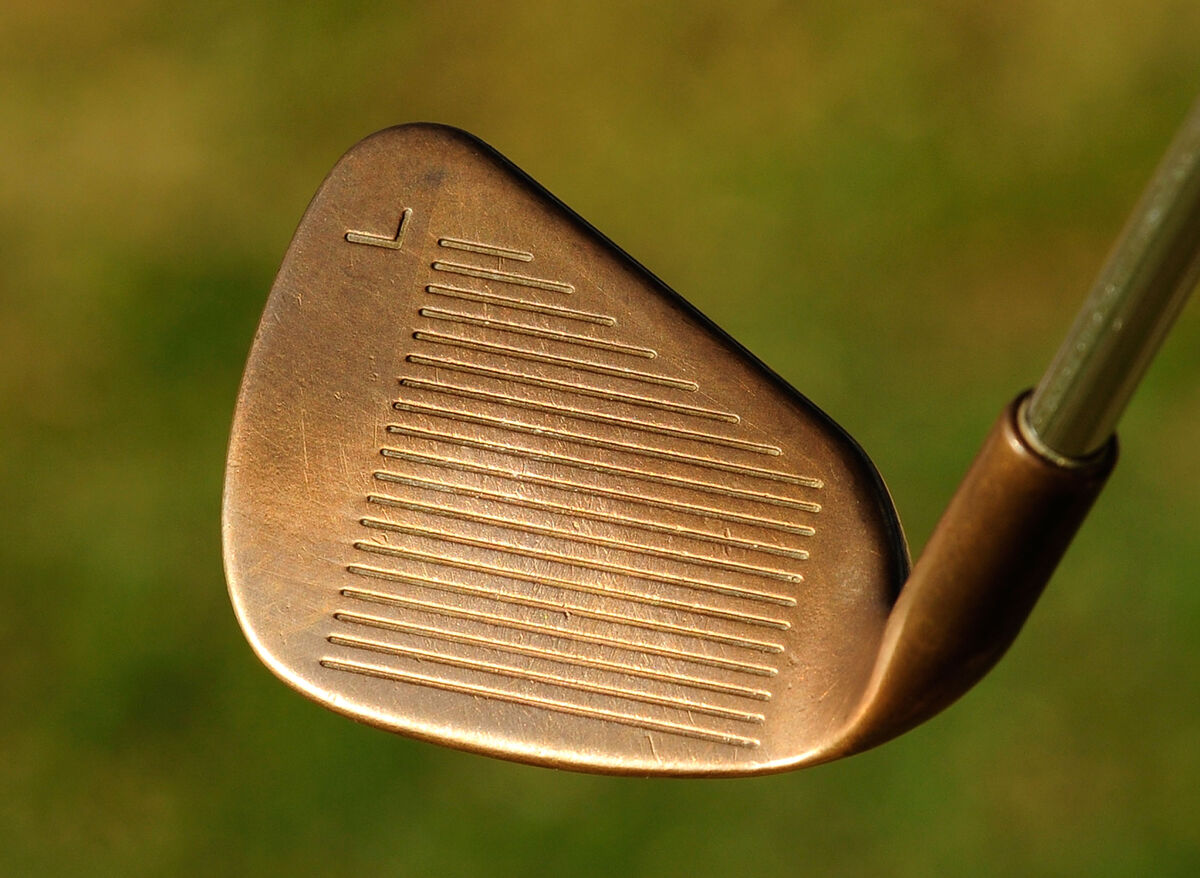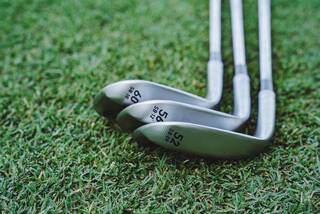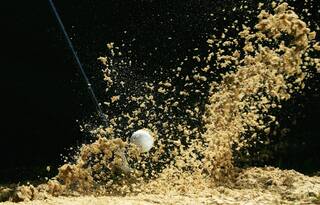The Lob Wedge Explained: 8 Answers You're Looking For
Most lob wedges have 58 or 60-degrees of loft. We answer the 8 most important lob wedge questions.

Did you know that the higher your golf handicap is, the better off you are sticking to one go-to club around the green, and the lower your handicap is, the more you should vary your greenside club selection based on the demands of the shot? With 58-60 degrees of loft, or sometimes even more, a lob wedge is a great option for some of the most demanding, highlight reel shots.
Here are the answers to the eight most popular lob wedge questions.
1. What is a Lob Wedge?
A lob wedge is a wedge with 58 or more degrees of loft, and if you carry one, it’s the most lofted club in your bag. A standard lob wedge is around 35-inches long, which also makes it the shortest club in your bag. The most common lob wedges are 58 or 60-degree wedges.
Today, most wedges are stamped with their loft, not their initial. For example, a 60-degree lob wedge is stamped with a "60" not an "L" on the sole. To translate a typical wedge setup, here's how wedge lofts might relate to the club names.
44-degree: Pitching Wedge
50-degree: Gap Wedge (or Approach Wedge)
56-degree: Sand Wedge
60-degree: Lob Wedge
Most wedges come with stock lofts in even degrees, and can be bent up or down a degree as needed to fit in with a player's wedge lineup.
While it is undeniably the go-to option for some of the most tricky greenside shots, for most golfers, the less you live and die by the lob wedge, the better off you are.
2. When Do You Use a Lob Wedge?
We’ve said this before and we’ll say it again. Golf is a game, and it’s supposed to be fun.
You know what else is fun? Hitting a tour-quality flop shot to gimme range in front of your friends. So, how do you hit a 60-degree wedge, or pull off fun greenside shots with your lob wedge?
With a lob wedge, a little bit of practice, and a juicy lie with a bunker to carry and just three paces of green between the fringe and the hole, you’ve got a decent chance of pulling off a flop shot.
The problem is, there’s really no such thing as an okay flop shot. They seem to either end up six inches from the hole, six inches from your feet, or 60 yards over the green. If you’re okay with risking a big number for the sake of a 19th hole laugh and a little more fun on the course, go for it.
Because a lob wedge is your most lofted club, it becomes the default option when you have little green to work with to stop the ball near the hole, or when you’re faced with a shot that requires you to get the ball up in the air quickly to avoid a bunker, tree, or other obstacle.
On the other hand, because of the high loft, launch, and spin that comes with a lob wedge, it’s much more difficult to consistently control the carry distance, trajectory and roll than it is with a lower-lofted wedge on those chip and pitch shots.
In other words, if you’re one of those higher-handicappers who benefits from a go-to greenside club, you’re less likely to get the approving “nice touch” compliment around the greens when you pull the lob wedge than you are with a lower lofted wedge like a sand wedge or gap wedge.
3. What is the Loft of a Lob Wedge?

A lob wedge is ideal when you have very little green to work with
A typical lob wedge has between 58 and 60 degrees of loft. Most manufacturers make lob wedges up to 60-64 degrees, but the USGA doesn’t limit the loft a wedge can have, and you can find niche lob wedges with 70 degrees of loft or more (although we highly recommend you don’t put one in your bag).
To decide how much loft should be on your lob wedge, consider the loft of your next-most-lofted club, and aim for about four degrees between them. For example, if you use a 56-degree sand wedge, consider a 60-degree lob wedge. Or if you use a 54-degree sand wedge, you might want a 58-degree lob wedge.
The number of wedges you carry can also influence the ideal loft of your lob wedge. If you choose to carry four wedges, (pitching, gap/approach, sand and lob), you can afford a smaller 4-degree gap between your sand and lob wedge. However, if you opt for a three-wedge setup, you might have a larger 6-8 degree gap. In that scenario, you might have a pitching wedge between 42-46 degrees, add another wedge between 50-54 degrees, and a lob wedge between 58-60 degrees.
The final thing you should consider with your lob wedge is the bounce and grind. The bounce is the angle between the leading edge and the trailing edge, and the grind is the shape of the sole. These have a much greater impact on a wedge’s performance than most people know.

How Understanding Wedge Bounce Can Help Your Golf Game
4. How Does a Lob Wedge Compare to a Sand Wedge?
If you’re mapping the 14 clubs in your golf bag, the lob wedge and sand wedge are next-door neighbors. Typically separated by just 4-6 degrees of loft and a quarter-inch of shaft length, the two wedges are fairly similar, but are anything but interchangeable.
Countless variables aside, a sand wedge should typically produce a carry-to-roll ratio of about 1:1, meaning a chip shot with a sand wedge that carries five yards should then roll out about five yards as well. A lob wedge, on the other hand, is more likely to fly twice as far as it rolls. If you hit a lob wedge five yards in the air, expect it to stop about 2-3 yards (call it eight feet) from where it lands.
The high loft on a lob wedge results in a less forgiving area of the face to strike the ball, which is less than ideal for most recreational golfers. That’s one of the reasons a lob wedge is best reserved for as-needed situations, rather than serving as a go-to option.
|
Sand Wedge |
Lob Wedge |
|
|
Standard Loft Range |
54-56 degrees |
58-60 degrees |
|
Carry-to-Roll |
1:1 |
2:1 |
|
Standard Length |
35.25 inches |
35.00 inches |
|
Best Uses |
Standard greenside shots that allow for roll |
Shots that must get in the air quickly and/or require limited roll |

Complete Guide to Golf Wedge Lofts
5. How Does a Lob Wedge Compare to a Pitching Wedge?
The lob wedge and pitching wedge are at opposite ends of the wedge spectrum. While your lob wedge is your most lofted club, your pitching wedge, generally between 42-48 degrees, is your least-lofted wedge.
Most golfers use their lob wedge for finesse shots around the green that demand precision over distance. That's why more often than not, you don’t swing your lob wedge at full speed in an effort to squeeze out maximum distance.
On the other hand, because a pitching wedge doesn’t stop quickly when used around the green, it’s more likely to be used further from the green with half, three-quarter, and full swings.
|
Pitching Wedge |
Lob Wedge |
|
|
Standard Loft Range |
42-48 degrees |
58-60 degrees |
|
Carry-to-Roll |
1:2 |
2:1 |
|
Standard Length |
35.75 inches |
35.00 inches |
|
Best Uses |
Longer shots with a full and ¾ swing, longer chip shots that allow for plenty of roll |
Shots that must get in the air quickly and/or require limited roll |
6. How Will a Lob Wedge Help My Game?
Even if your lob wedge is not your go-to greenside club, most recreational golfers will still find a use for it several times per round.
The average 10-handicap golfer only hits about one-third of the greens in regulation during a round. That number drops to less than one-out-of-four for 15-handicap players. That means most recreational golfers find themselves in greenside chipping and pitching situations between 12-15 times per round, and the more options you have to hit those shots, the better off you are.
Having a lob wedge that you can confidently hit over a greenside bunker or stop quickly on the greens can lead to more stroke-saving up-and-downs throughout your round.
7. How Do You Pitch and Chip With a Lob Wedge?
27-time LPGA Tour winner Jane Blalock demonstrates how to use the lofted wedge around the green.
Using your most lofted club, in this case your lob wedge , you can open the club face to create even more loft as needed. Make a big swing, with a slightly outside takeaway, then accelerate through the ball into a high, soft finish. That gives you control, and when you use your lob wedge, it allows you to hit the ball high and stop it softly on the green.
Keep in mind, this is one of the more difficult shots in golf, so be sure to practice it until you’re comfortable with it before you bring it to the course.
If you don’t feel confident that you can execute the lob, or flop shot, on the course, you can play it safe but hitting a more simple pitch or chip shot onto the green, and accepting that you’ll likely face a longer putt in exchange for eliminating a disastrous result from a failed flop shot.
8. How Do You Buy a Lob Wedge?
If you’re looking to buy a lob wedge, you have a few considerations. Are you adding the lob wedge to your existing wedge setup, or replacing all of your wedges simultaneously?
If you have a sand wedge that you’re satisfied with and want to add a lob wedge to your arsenal, look for the same brand and model of wedge, and get a matching lob wedge with 4-6 degrees more loft than your sand wedge. There are most likely plenty of new and used options available. If you search for used wedges, however, keep in mind that wedges are the quickest clubs in your bag to wear out, and check out the Dos and Don’ts of Buying Used Wedges before adding a used wedge to your bag.

Dos and Don'ts of Buying Used Wedges, According to a Master Fitter
On the other hand, if you’re considering replacing multiple wedges, you can put together a suite of wedges that offers you every loft, bounce and grind option you need for your stroke and the typical courses you play. On top of that, the condition of the grooves on your wedges will be consistent from one wedge to the next, which is another important detail that often gets overlooked.